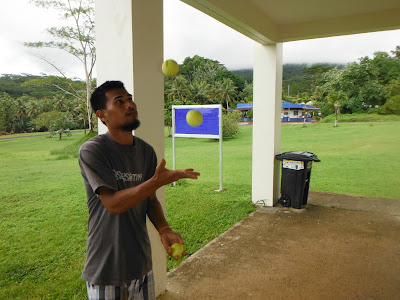Flying objects and mathematical models
The weather permitted a laboratory fourteen in which I have the students explore for mathematical models underneath airborne objects. This term I included a princess ball in the mix, flying disks, flying rings, and an aerobie. I had the students report data back to the board and tasked the class with a four table, four graph report using the multigraph rubric available to me in Schoology.
Laboratory fourteen data post-lab. Each pair only worked with a single object. The pooling of results is reminiscent of laboratory six and is being considered as a reworking for laboratory five on friction.
Equipment included GPS units to measure distance, a radar gun to obtain launch speeds. All throws were to be horizontal.
Laboratory fifteen again explored site swap notation. This term I opted to use what I think of as the alternate introduction to the laboratory. Being summer term I had just shown Morgan Freeman's "What are we really made of?" I used this as a jumping off point to put up a diagram using alpha, beta, and three electrons.
This term only one student nodded when asked if they understood. Still, one student reacted positively, when what I had put on the board was effectively nonsense.
I then noted for the benefit of the pre-teacher prep majors that students will say they understand when they do not, when they could not. I went on to demonstrate the actual system, generating a new site swap 3 diagram and explaining the meaning of each part physically using three balls.
I went on to demonstrate and show a 51, and finally ran a 342 site swap both on the board and with the balls. Now more students claimed to understand the notation. I cautioned them that I was still no more certain of comprehension than before. I suggested that they try to perform a 3 and, if they could master that, then to try a 51 and a 342.
I also lobbied for not teaching mathematics as an abstract system devoid of physicality. Just as the alpha-beta diagram was meaningless and confusing, so is the abstract approach of the typical math class. Yes, of course there are "real world word problems" but those are after the fact.
I advocate the approach I take in physical science: start with a system. Measure, analyze, and then repeat with a new system. The mathematics should always have a meaning. Sure, physics may be equally inapplicable to the future for many students, but at least they will know where that math arises and what it is used for.
Laboratory fourteen data post-lab. Each pair only worked with a single object. The pooling of results is reminiscent of laboratory six and is being considered as a reworking for laboratory five on friction.
Equipment included GPS units to measure distance, a radar gun to obtain launch speeds. All throws were to be horizontal.
Preliminary results do not argue for any strongly nonlinear model. Thus one is left using a linear model for the four types of objects. The slopes appear to well reflect the expected distance performance for the objects. The Aerobie has a unique air foil to deliver maximum distance, rings outperform disks aerodynamically, and balls do not fly in the airfoil sense of the word. And the slopes stacked up just this way.
Mayleen Samuel
Laboratory fifteen again explored site swap notation. This term I opted to use what I think of as the alternate introduction to the laboratory. Being summer term I had just shown Morgan Freeman's "What are we really made of?" I used this as a jumping off point to put up a diagram using alpha, beta, and three electrons.
Neikaman
This term only one student nodded when asked if they understood. Still, one student reacted positively, when what I had put on the board was effectively nonsense.
Neikaman would demonstrate a 342 site swap
I then noted for the benefit of the pre-teacher prep majors that students will say they understand when they do not, when they could not. I went on to demonstrate the actual system, generating a new site swap 3 diagram and explaining the meaning of each part physically using three balls.
I went on to demonstrate and show a 51, and finally ran a 342 site swap both on the board and with the balls. Now more students claimed to understand the notation. I cautioned them that I was still no more certain of comprehension than before. I suggested that they try to perform a 3 and, if they could master that, then to try a 51 and a 342.
Sucy-ann Liwy showing a 3 site swap
I also lobbied for not teaching mathematics as an abstract system devoid of physicality. Just as the alpha-beta diagram was meaningless and confusing, so is the abstract approach of the typical math class. Yes, of course there are "real world word problems" but those are after the fact.
Gino Retogluwe working on a 3.
I advocate the approach I take in physical science: start with a system. Measure, analyze, and then repeat with a new system. The mathematics should always have a meaning. Sure, physics may be equally inapplicable to the future for many students, but at least they will know where that math arises and what it is used for.
Joemar Wasan flashes a 3
Mayleen would master 3, show a 51, and perform a 342 swap
Marsha Solomon working on a 3
Neika working on 51
Mayleen showing good control
Shirely-Ann Rudolph
Marsha.
Neika




















Comments
Post a Comment